-
ORIGINAL ARTICLE07-29-2024
Contribution of informal caregivers to self-care in individuals with heart failure
Revista Brasileira de Enfermagem. 2024;77(3):e20230492
Abstract
ORIGINAL ARTICLEContribution of informal caregivers to self-care in individuals with heart failure
Revista Brasileira de Enfermagem. 2024;77(3):e20230492
DOI 10.1590/0034-7167-2023-0492
Views0See moreABSTRACT
Objectives:
to evaluate the contribution of informal caregivers to the self-care of individuals with heart failure.
Methods:
a cross-sectional study was conducted with 87 caregivers from March to October 2022 in the city of João Pessoa/PB. The caregivers’ contribution was assessed using the Caregiver Contribution to Self-Care of Heart Failure Index instrument. Scores ≥ 70 points indicate adequate contribution. Data were analyzed using descriptive statistics and Spearman’s correlation.
Results:
the sample consisted of 81.6% female caregivers. Median scores obtained for the self-care contribution scales were: 63.3 for maintenance; 55.5 for management; and 66.6 for confidence. Caregivers never or rarely recommended monitoring body weight, regular physical exercise, extra use of diuretics, and fluid restriction.
Conclusions:
informal caregivers showed inadequate contribution in the areas of maintenance, management, and confidence in self-care of individuals with heart failure.
-
07-29-2024
Reflections on theoretical framework use in nursing research
Revista Brasileira de Enfermagem. 2024;77(3):e20230486
Abstract
Reflections on theoretical framework use in nursing research
Revista Brasileira de Enfermagem. 2024;77(3):e20230486
DOI 10.1590/0034-7167-2024-0486
Views0See moreABSTRACT
Objectives:
to reflect on theoretical framework use in nursing research.
Methods:
a theoretical-reflexive study, based on concepts and constructs pertinent to using nursing theories and other sciences, considering issues of epistemology or philosophy of science.
Results:
we presented what it is and why to do nursing research and what a theoretical framework is and why to use it, in addition to some considerations regarding theoretical framework use in nursing research, essential for constructing disciplinary knowledge, which enables the materialization of researchers’ work and the presentation of propositions resulting from investigations in and for nursing as a discipline and science.
Final Considerations:
based on a reflection based on epistemological conceptions, it is possible to affirm that a theoretical framework is the core of researchers’ thinking, delimiting a problem to be investigated and, based on it, outlining methodological strategies to be followed, supporting nursing action and thinking as discipline and science.

-
REVIEW07-29-2024
Nursing diagnoses for people hospitalized with heart failure: an integrative review
Revista Brasileira de Enfermagem. 2024;77(3):e20230471
Abstract
REVIEWNursing diagnoses for people hospitalized with heart failure: an integrative review
Revista Brasileira de Enfermagem. 2024;77(3):e20230471
DOI 10.1590/0034-7167-2023-0471
Views0See moreABSTRACT
Objectives:
to identify in the literature the main nursing diagnoses according to the NANDA-I diagnostic classification for people hospitalized with heart failure.
Methods:
an integrative literature review, carried out in February 2019 and updated in July 2023, in the MEDLINE via PubMed, LILACS, SciELO and CINAHL databases. Given the use of acronym PEO, studies without a time cut in Portuguese, English and Spanish were included. Descriptive analysis was carried out to present the identified information.
Results:
analysis of 27 articles identified 24 nursing diagnoses, with emphasis on Decreased Cardiac Output, Excessive Fluid Volume, Decreased Activity Tolerance and Fatigue.
Final Considerations:
evidence can contribute to better diagnostic decisions centered on people with heart failure in search of more assertive health results and have the potential to support future studies on a possible syndromic pattern in this population.
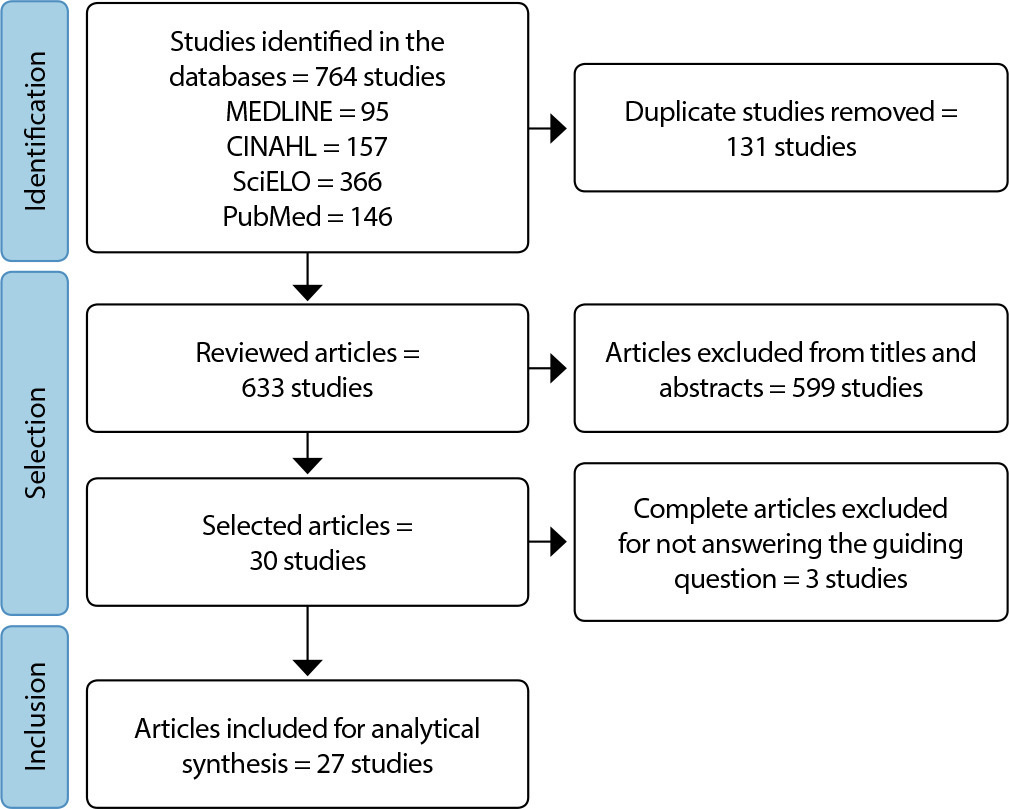
-
ORIGINAL ARTICLE07-29-2024
Primary Health Care in transitional care of people with stroke
Revista Brasileira de Enfermagem. 2024;77(3):e20230468
Abstract
ORIGINAL ARTICLEPrimary Health Care in transitional care of people with stroke
Revista Brasileira de Enfermagem. 2024;77(3):e20230468
DOI 10.1590/0034-7167-2024-0468
Views0See moreABSTRACT
Objectives:
to understand the role of Primary Health Care teams in caring for people with stroke after hospital discharge.
Methods:
single case study, with integrated units of analysis, with a qualitative approach. Data triangulation occurred through interviews with professionals and family caregivers involved in transition of care, in addition to direct observations in rounds and document analysis. For the analyses, the analytical strategies of theoretical propositions and construction of explanations were used, with the help of ATLAS.ti®.
Results:
the importance of counter-referral, the role of community health workers and the multidisciplinary team, health promotion, secondary prevention, home visits as a visceral attribute and nurses as care managers are evident.
Final Considerations:
the high demand on teams and the Social Determinants of Health interfere with adequate continuity of care. Transitional care programs that enable continuity of care are recommended.
-
ORIGINAL ARTICLE07-29-2024
Completeness of variables in Hospital-Based Cancer Registries for prostatic malignant neoplasm
Revista Brasileira de Enfermagem. 2024;77(3):e20230467
Abstract
ORIGINAL ARTICLECompleteness of variables in Hospital-Based Cancer Registries for prostatic malignant neoplasm
Revista Brasileira de Enfermagem. 2024;77(3):e20230467
DOI 10.1590/0034-7167-2023-0467
Views0See moreABSTRACT
Objectives:
to analyze the completeness of variables from Hospital-Based Cancer Registries of cases of prostate neoplasm in the Oncology Care Network of a Brazilian state between 2000 and 2020.
Methods:
an ecological time series study, based on secondary data on prostate cancer Hospital-Based Cancer Registries prostate. Data incompleteness was classified as excellent (<5%), good (between 5%-10%), fair (10%-20%), poor (20%-50%) and very poor (>50%), according to the percentage of lack of information.
Results:
there were 13,519 cases of prostate cancer in the Hospital-Based Cancer Registries analyzed. The variables “family history of cancer” (p<0.001), “alcoholism” (p<0.001), “smoking” (p<0.001), “TNM staging” (p<0.001) had a decreasing trend, while “clinical start of treatment” (p<0.001), “origin” (p=0.008) and “occupation” (p<0.001) indicated an increasing trend.
Conclusions:
most Hospital-Based Cancer Registries variables showed excellent completeness, but important variables had high percentages of incompleteness, such as TNM and clinical staging, in addition to alcoholism and smoking.
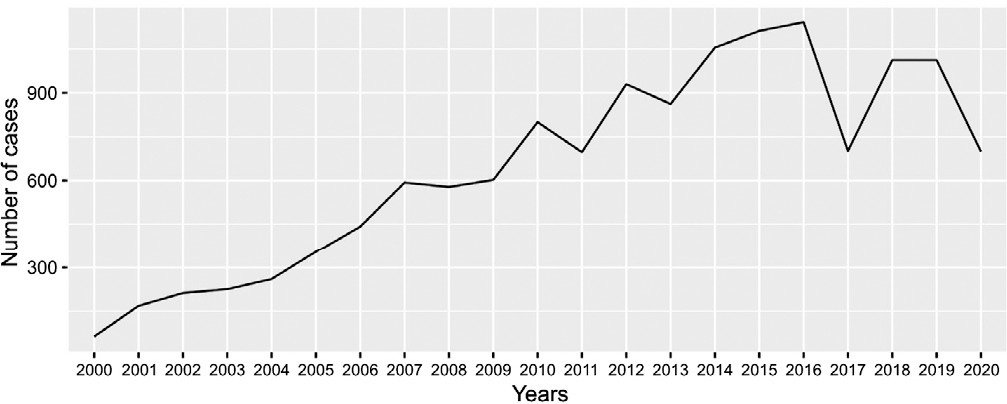
-
ORIGINAL ARTICLE07-29-2024
Disrupted mother-fetus dyad risk in high-risk pregnancies: a Middle-Range Theory
Revista Brasileira de Enfermagem. 2024;77(3):e20230464
Abstract
ORIGINAL ARTICLEDisrupted mother-fetus dyad risk in high-risk pregnancies: a Middle-Range Theory
Revista Brasileira de Enfermagem. 2024;77(3):e20230464
DOI 10.1590/0034-7167-2023-0464
Views0See moreABSTRACT
Objectives:
to develop and evaluate a Middle-Range Theory for the nursing diagnosis “Disrupted Mother-Fetus Dyad Risk” in high-risk pregnancies.
Methods:
this methodological study was conducted in two stages: theory development and evaluation. Dorothea Orem’s General Nursing Model was used as the theoretical-conceptual foundation. Evaluation was conducted using the Delphi method with seven judges, and consensus was achieved when the Content Validity Index of the evaluated items was ≥ 0.80.
Results:
the theory identified 20 elements of the nursing diagnosis “Disrupted Mother-Fetus Dyad Risk” (10 risk factors, 4 at-risk populations, and 6 associated conditions), 14 propositions, and 1 pictogram. After two rounds of evaluation, the theory was considered consistent, with consensus reached for all items, each achieving a Content Validity Index ≥ 0.80.
Conclusions:
the Middle-Range Theory included biopsychosocial factors explaining the nursing phenomenon “Disrupted Mother-Fetus Dyad Risk,” which aids in nurses’ diagnostic reasoning.
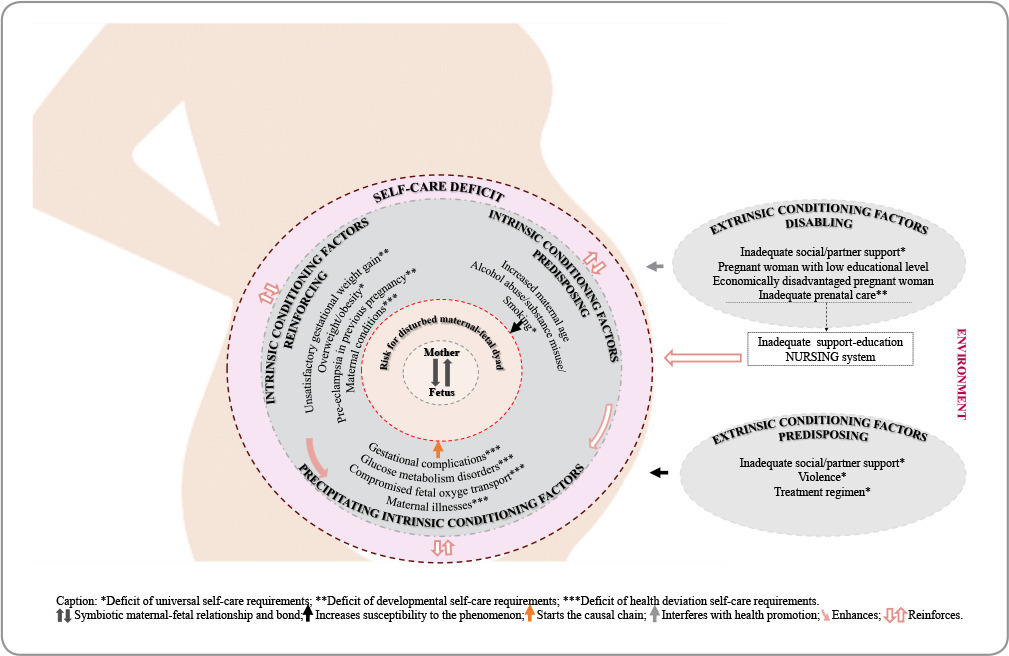
-
ORIGINAL ARTICLE07-29-2024
Mental health of parents of children and adolescents who require special health care
Revista Brasileira de Enfermagem. 2024;77(3):e20230457
Abstract
ORIGINAL ARTICLEMental health of parents of children and adolescents who require special health care
Revista Brasileira de Enfermagem. 2024;77(3):e20230457
DOI 10.1590/0034-7167-2023-0457
Views0See moreABSTRACT
Objective:
To identify the manifestations presented by parents of children and adolescents who require special health attention that can impact their mental health.
Methods:
exploratory, qualitative research, based on the concept of vulnerability, with data collection carried out through interviews with 18 parents of children and adolescents with special health care needs, hospitalized in the pediatric ward of a hospital in Paraná, between May/2017 and May/ 2018. Data analyzed by inductive thematic analysis.
Results:
parents experienced situations of vulnerability when providing care at home, with repercussions on their mental health, expressed by manifestations of lack of protection, anxiety and depression.
Final considerations:
It is important that health professionals seek to expand actions to promote care and reduce situations that generate threats, insecurities, concerns and damage to the health of parents, which can impact and further weaken care for children and adolescents who need attention especially health.
-
ORIGINAL ARTICLE07-29-2024
Evidence of validity of the Risk Self-Medication Questionnaire focused on Health Literacy
Revista Brasileira de Enfermagem. 2024;77(3):e20230386
Abstract
ORIGINAL ARTICLEEvidence of validity of the Risk Self-Medication Questionnaire focused on Health Literacy
Revista Brasileira de Enfermagem. 2024;77(3):e20230386
DOI 10.1590/0034-7167-2023-0386
Views0See moreABSTRACT
Objectives:
to analyze the validity evidence of the internal structure of the Risk Self-Medication Questionnaire Focused on Health Literacy.
Methods:
a psychometric study with 499 adults. The internal structure was assessed with exploratory and confirmatory factor analysis to prove the adjustment. Internal consistency was measured by composite reliability and McDonald’s omega coefficient (ω).
Results:
the parameters revealed a model of 35 items distributed across four factors, explaining 56% of the total variance, with factor loadings ranging from 0.31 to 0.85 and adequate communalities. Accuracy (0.79
Conclusions:
an instrument was obtained with good evidence of structural validity for measuring self-medication.
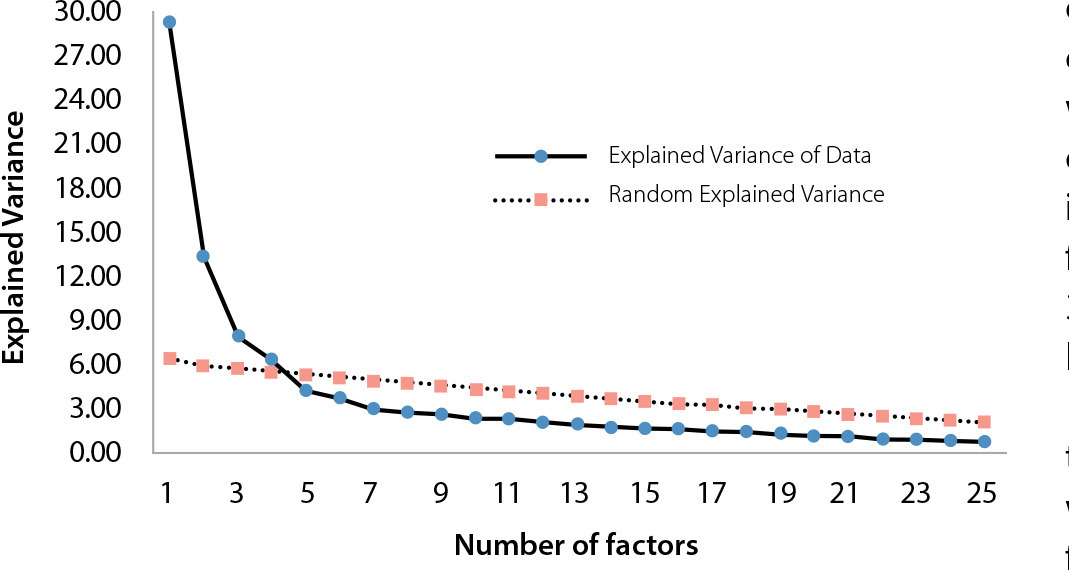
-
REVIEW07-31-2020
Educational practices for families of children and adolescents using a permanent venous catheter
Revista Brasileira de Enfermagem. 2020;73:e20190129
Abstract
REVIEWEducational practices for families of children and adolescents using a permanent venous catheter
Revista Brasileira de Enfermagem. 2020;73:e20190129
DOI 10.1590/0034-7167-2019-0129
Views0See moreABSTRACT
Objectives:
to identify, in the scientific literature, the educational practices performed by nurses with the families of children and adolescents using long-term venous catheters, concerning home care.
Methods:
integrative review in LILACS, PubMed, SCOPUS, Web of Science and CINAHL databases, from August to September 2018.
Results:
we analyzed eight articles that met the inclusion criteria. The results showed that all studies are international, mostly North American and with low level of evidence. The educational practices found were home visits, production of printed educational materials, use of mannequins for simulation, creation of an educational video, and combined educational practices.
Final Considerations:
the care provided by families at home in the countries studied is more complex than in Brazil, and the conclusion is that Brazilian studies need to advance in publications related to this area.
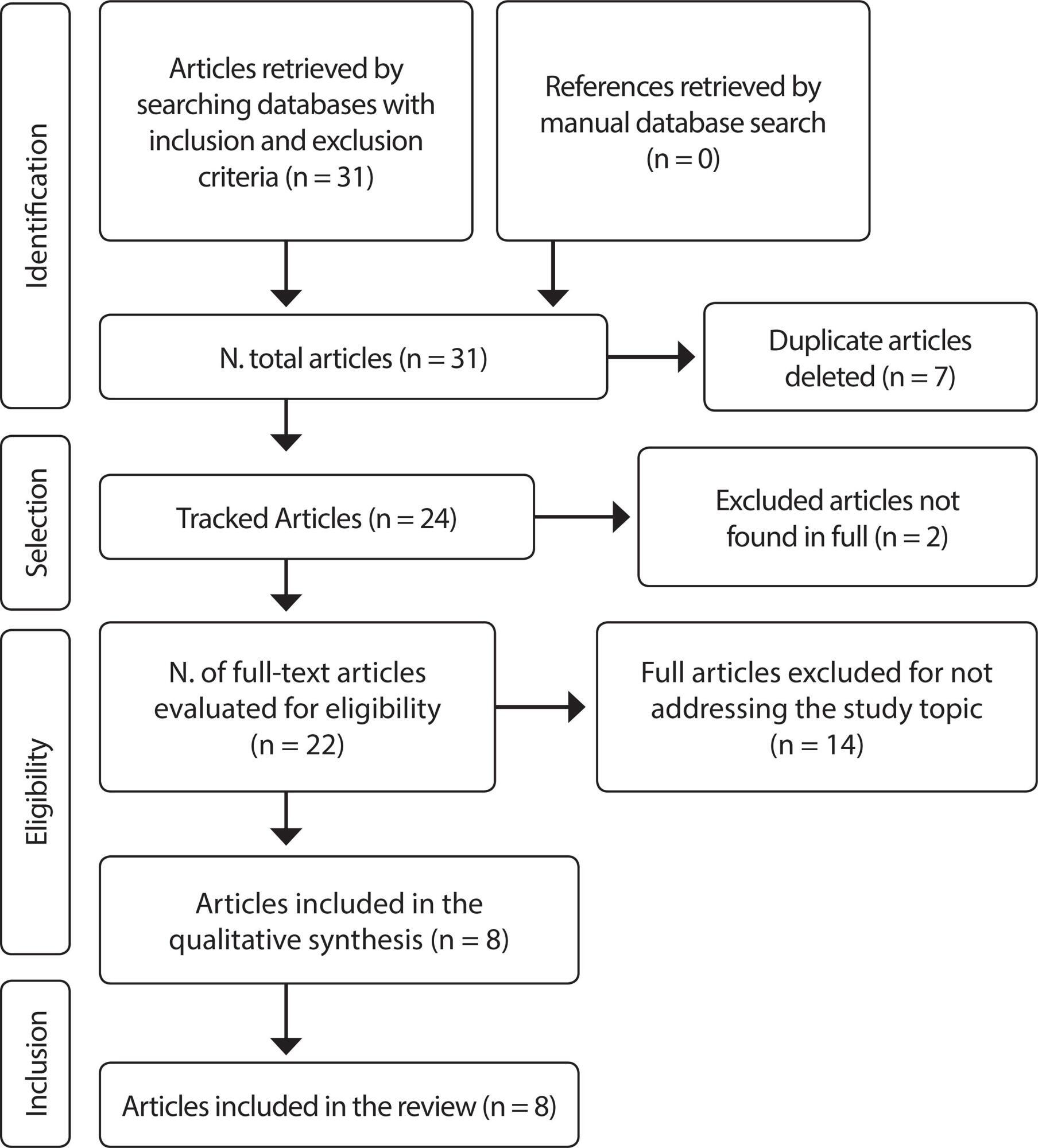
-
REVIEW07-17-2020
Approaches to workload in psychiatric and mental health nursing
Revista Brasileira de Enfermagem. 2020;73:e20190620
Abstract
REVIEWApproaches to workload in psychiatric and mental health nursing
Revista Brasileira de Enfermagem. 2020;73:e20190620
DOI 10.1590/0034-7167-2019-0620
Views0See moreABSTRACT
Objective:
to investigate approaches to workload in psychiatric and mental health nursing in Brazilian and international production of knowledge
Methods:
integrative literature review using six databases, covering January 2005 to March 2019. Articles in full in English, Spanish and Portuguese were included.
Results:
the sample consisted of 23 original articles classified as quantitative or emotional. The quantitative dimension was addressed in 12 articles and included: assessing patient care needs, identifying activities performed by the team, measuring time spent and developing and validating a measurement instrument. The emotional dimension included 11 articles the focus of which was on identifying stressors in the workplace, psychosocial risks and coping strategies.
Conclusion:
strategies were found for measuring workload and assessing the impact of stressors on nursing teams.
-
ORIGINAL ARTICLE10-19-2020
Problematization educational intervention to promote healthy habits in elderly people with diabetes: randomized clinical trial
Revista Brasileira de Enfermagem. 2020;73:e20190719
Abstract
ORIGINAL ARTICLEProblematization educational intervention to promote healthy habits in elderly people with diabetes: randomized clinical trial
Revista Brasileira de Enfermagem. 2020;73:e20190719
DOI 10.1590/0034-7167-2019-0719
Views0See moreABSTRACT
Objective:
to assess the effects of a problematization educational intervention to promote healthy habits in elderly people with diabetes.
Methods:
a randomized clinical trial conducted with 202 individuals drawn for the intervention group and the control group. The intervention consisted of problematization educational activities on a monthly basis for over six months. The control group participated in conventional monitoring at the health unit. Data were collected through semi-structured interviews before and after the intervention, in addition to laboratory tests.
Results:
after the intervention, when compared to the control group, there was an increase in knowledge about the disease (p<0.001), positive attitude towards self-care (p=0.011), physical activity (p=0.020), diet variety (p=0.002), and lower consumption of oils and fats (p<0.05).
Conclusion:
the intervention performed has a beneficial effect to promote healthy habits.
-
ORIGINAL ARTICLE10-23-2020
Active ageing among elderly community members: structural equation modeling analysis
Revista Brasileira de Enfermagem. 2020;73:e20200110
Abstract
ORIGINAL ARTICLEActive ageing among elderly community members: structural equation modeling analysis
Revista Brasileira de Enfermagem. 2020;73:e20200110
DOI 10.1590/0034-7167-2020-0110
Views0See moreABSTRACT
Objective:
to propose a structural model of active ageing among elderly community members based on the World Health Organization’s theoretical framework and to identify the most relevant determinants of active ageing to the proposed model.
Methods:
a cross-sectional and analytical study conducted with 957 elderly community members. Confirmatory factor analysis and structural equation modeling were performed.
Results:
the final measurement model was composed of the six determinants of active ageing: behavioral (R²=0.66); personal (R²=0.74); physical environment (R²=0.70); social (R²=0.77); economic (R²=0.44); and social and health services (R²=0.95). The last one showed good quality of adjustment: χ2/gl=3.50; GFI=0.94; CFI=0.92; TLI=0.90; RMSEA=0.05. By analyzing the trajectories between determinants and active ageing, the most representative was social and health services active ageing (λ=0.97; p<0.001).
Conclusion:
satisfaction with access to health services and positive self-assessment of health status were the factors that most contributed to active ageing in this population.
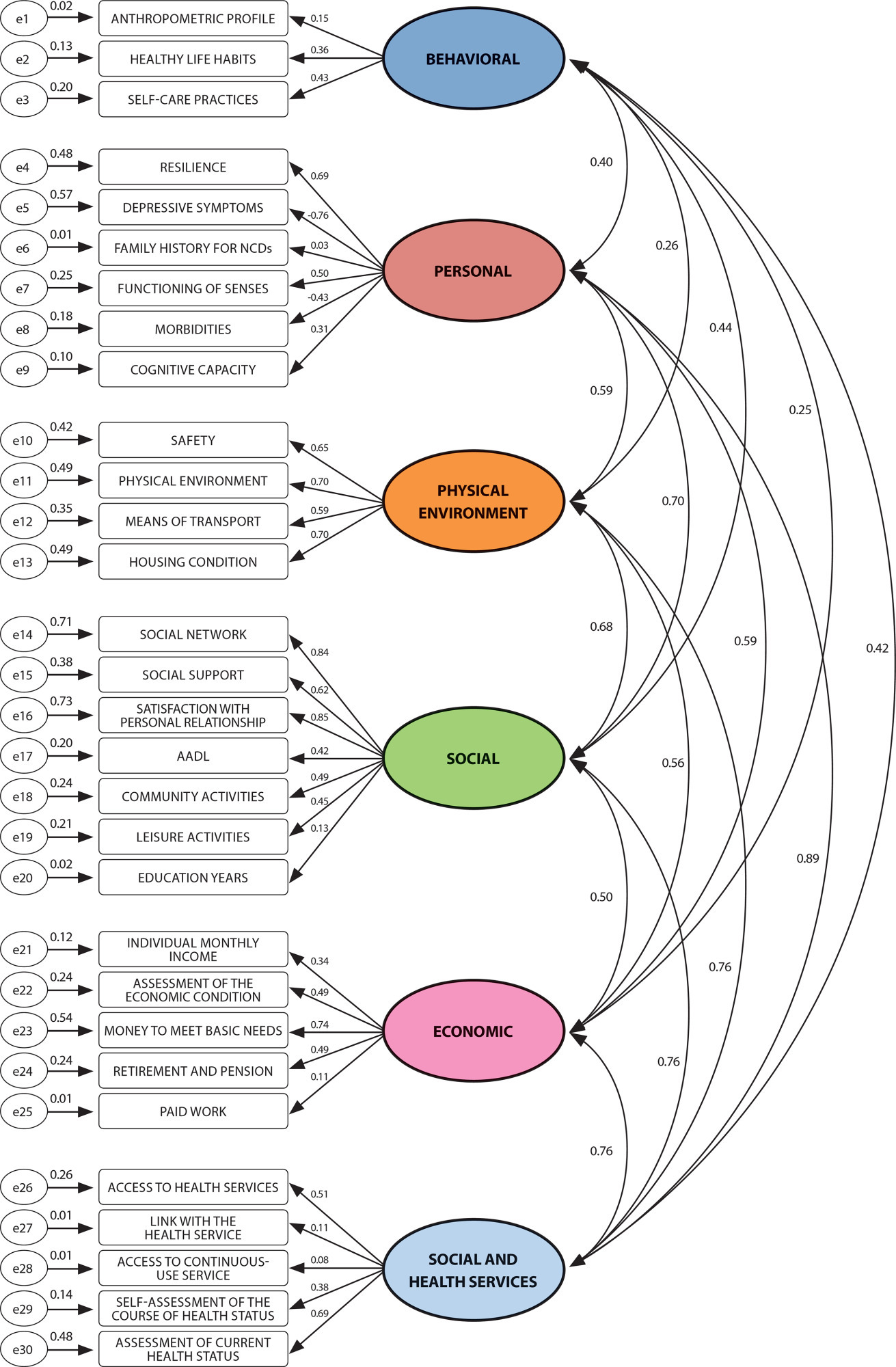
-
ORIGINAL ARTICLE05-28-2021
Nurses’ educational practices in Family Health Strategy
Revista Brasileira de Enfermagem. 2021;74(2):e20200045
Abstract
ORIGINAL ARTICLENurses’ educational practices in Family Health Strategy
Revista Brasileira de Enfermagem. 2021;74(2):e20200045
DOI 10.1590/0034-7167-2020-0045
Views0See moreABSTRACT
Objectives:
to analyze the nurse’s educational practice in Family Health Strategy.
Methods:
descriptive study with a qualitative approach, whose data production used the World Café group technique, in two meetings, with 26 nurses of a health district of Manaus-AM. The technique used was Categorial-Thematic Content Analysis.
Results:
the study generated two units of analysis: Political and Organizational Configuration of Educational Work at ESF and Operational Configuration of Educational Work at ESF, revealing the necessary (re)configurations in co-management, in the centrality of the subject for the planning of educational work, and in (re)pactuation between the management of services and training institutions to overcome contradictions in the implementation of National Policies on Permanent Education and Basic Health Care.
Conclusions:
the configuration of nurses’ educational practice at ESF works toward interactions, organized to respond to health policies, incorporating creativity in doing, but facing numerous obstacles.
-
ORIGINAL ARTICLE08-13-2021
Analysis of diagnostic criteria for ventilator-associated pneumonia: a cohort study
Revista Brasileira de Enfermagem. 2021;74(6):e20190653
Abstract
ORIGINAL ARTICLEAnalysis of diagnostic criteria for ventilator-associated pneumonia: a cohort study
Revista Brasileira de Enfermagem. 2021;74(6):e20190653
DOI 10.1590/0034-7167-2019-0653
Views0See moreABSTRACT
Objectives:
to analyze the diagnostic criteria for ventilator-associated pneumonia recommended by the Brazilian Health Regulatory Agency and the National Healthcare Safety Network/Centers for Disease Control and Prevention, as well as its risk factors.
Methods:
retrospective cohort study carried out in an intensive care unit throughout 12 months, in 2017. Analyses included chi-square, simple linear regression, and Kappa statistical tests and were conducted using Stata 12 software.
Results:
the sample was 543 patients who were in the intensive care unit and under mechanical ventilation, of whom 330 (60.9%) were men and 213 (39.1%) were women. Variables such as gender, age, time under mechanical ventilation, and oral hygiene proved to be significant risk factors for the development of ventilator-associated pneumonia.
Conclusions:
patients submitted to mechanical ventilation need to be constantly evaluated so the used diagnostic methods can be accurate and applied in an objective and standardized way in Brazilian hospitals.
-
06-11-2021
Severe acute postoperative pain self-reported by children after ambulatory surgeries: a cohort study
Revista Brasileira de Enfermagem. 2021;74:e20200151
Abstract
Severe acute postoperative pain self-reported by children after ambulatory surgeries: a cohort study
Revista Brasileira de Enfermagem. 2021;74:e20200151
DOI 10.1590/0034-7167-2020-0151
Views1See moreABSTRACT
Objectives:
to estimate the incidence and the risk factors for severe acute postoperative pain self-reported on the first day after hospital discharge.
Methods:
cohort study with 279 children from both sexes (5-12 years old), indicated for ambulatory surgery in two Brazilian hospitals. Children were assessed at the pre-surgery, immediate postoperative and first postoperative day. Faces Pain Scale-Revised and Yale Preoperative Anxiety Scale Modified were used. Severe postoperative pain was defined as score ≥6. Cox regression analyses were used.
Results:
the incidence of severe postoperative pain was 15.8% (95%CI:10.7%-20.4%) on the first postoperative day. Preoperative anxiety (HR=2.23; p=0.049), severe preoperative pain (HR=2.78; p=0.031) and having undergone two surgical procedures (HR=2.91; p=0.002) were associated with severe postoperative pain.
Conclusions
the incidence of severe postoperative pain self-reported after hospital discharge was high. Anxiety and severe preoperative pain, in addition to performing two surgical procedures at the same time were confirmed as risk factors.
-
ORIGINAL ARTICLE07-15-2020
Presumption of sexual abuse in children and adolescents: vulnerability of pregnancy before 14 years
Revista Brasileira de Enfermagem. 2020;73:e20190143
Abstract
ORIGINAL ARTICLEPresumption of sexual abuse in children and adolescents: vulnerability of pregnancy before 14 years
Revista Brasileira de Enfermagem. 2020;73:e20190143
DOI 10.1590/0034-7167-2019-0143
Views0See moreABSTRACT
Objectives:
to investigate the presumption of sexual abuse through the records of live births with mothers up to 13 years of age.
Methods:
this is a quantitative study, with an ecological design, carried out in Maceió, with data from the Brazilian Live Birth Information System from 2009 to 2017, based on Law 12,015/2009, on sexual crimes against the vulnerable, applying the presumption of violence in children under 14 years old.
Results:
nine hundred fifty-three births of children with mothers aged 10 to 13 years were recorded; 1.3% were reported as victims of sexual abuse; 20.3% declared to be married or living in a stable relationship. Records were concentrated in 04 neighborhoods, Guaxuma, Benedito Bentes, Tabuleiro do Martins, and Jacintinho.
Conclusions:
there was a prevalence of pregnancy and marriage in girls under 14 years of age and scarcity of reporting presumed sexual abuse by health professionals.
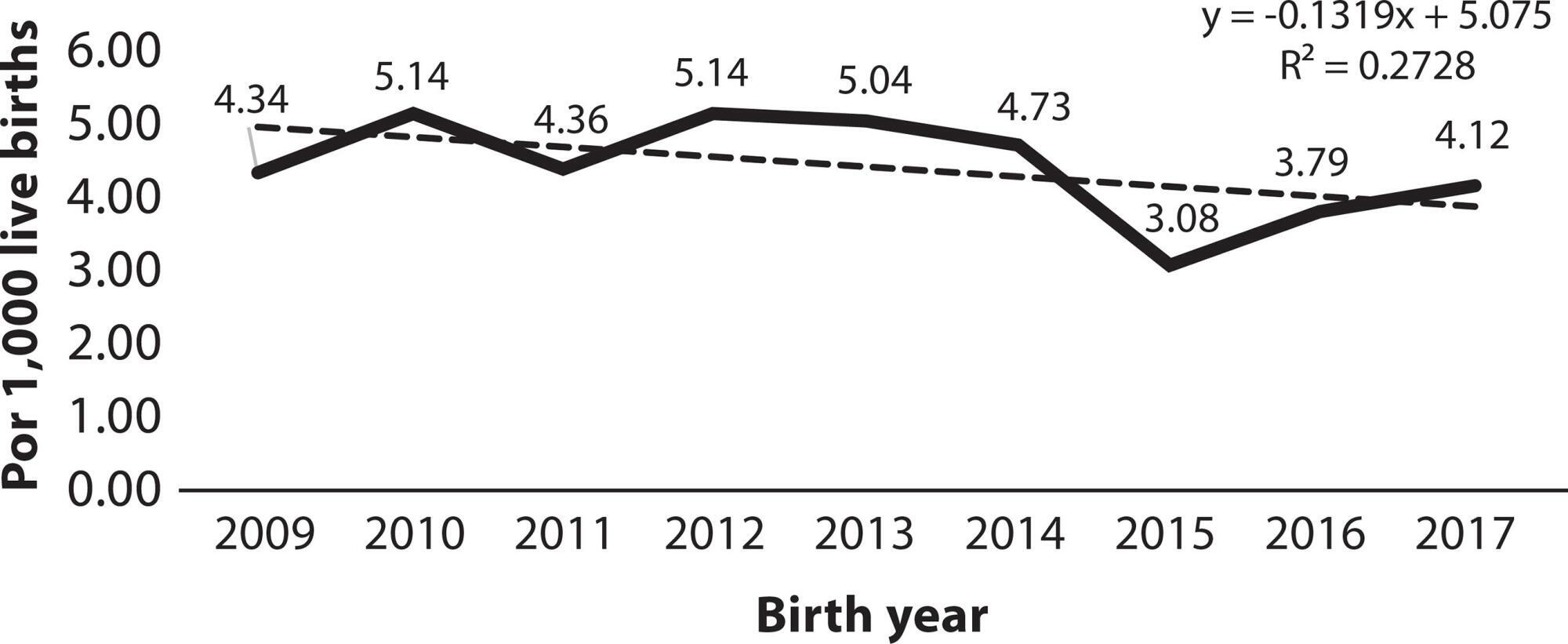
Search
Search in:
Nuvem de Tags
Adolescente (85) Atenção Primária à Saúde (239) COVID-19 (91) Criança (91) Cuidados de Enfermagem (269) Educação em Enfermagem (151) Educação em Saúde (139) Enfermagem (930) Enfermagem Pediátrica (86) Estudantes de Enfermagem (77) Estudos de Validação (131) Família (87) Idoso (208) Promoção da Saúde (99) Qualidade de Vida (104) Saúde do Trabalhador (86) Saúde Mental (145) Saúde Pública (82) Segurança do Paciente (150) Tecnologia Educacional (100)



